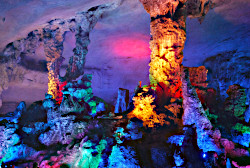Coloured Light

Coloured Light, as the name says, is the use of non-white light for illumination. White light is actually not simply white. White is not a colour, white means a combination of many colours which add to become white. White light has a so-called temperature, which is measured in degrees, like normal temperature. It means that the light is either warm and a little yellowish, or that it is cool and a little blueish. Nevertheless, it is called white. The cool end is sometimes called industrial white. Any things that are illuminated by white light become visible only by the reflection of this white light. What we perceive is the reflected light. But different surfaces reflect white light only partially, which gives the objects different colors. If the object reflects only the green frequency, it is green to us.
Coloured light is not "coloured", nothing is added, it is filtered, so something is taken away. All frequencies except one are removed, and so only this single frequency or colour remains. If such a light is reflected by an object, it can only reflect this single colour, because there is nothing else. In other words, if you mount a red lamp, a blue object will appear red.
Caves have speleothems with fine colours from white to brown, different hues of natural colouring. There are grey and even slightly blueish colours. If you illuminate them with red light, they have only one colour, and that’s red. Caves with coloured light look either like brothels or like Christmas decoration. Colored light is a good way to cover up minor flaws.
Unfortunately coloured light is very popular in Asian countries, especially China and Japan. They are actually quite proud of their colourful illumination.
 Search DuckDuckGo for "Coloured Light"
Search DuckDuckGo for "Coloured Light"
 Index
Index Topics
Topics Hierarchical
Hierarchical Countries
Countries Maps
Maps